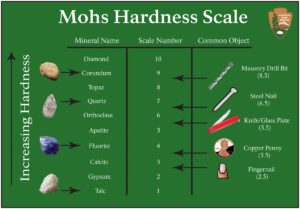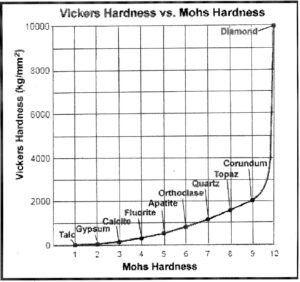Diamonds have been said to be “a girl’s best friend,” and that may be true for some very materialistic girls because top quality natural diamonds are extremely rare and expensive. A diamond is a mineral form of carbon that is the hardest natural substance known. Secular sources state that it takes billions of years for diamonds to form. The Bible’s historical timeline only allows for an earth that is six to seven thousand years old. What light can true science shine on this controversy about the age of diamonds? I will discuss that question and what I believe is a reasonable creationist answer to it later in this article, after we take a look at some additional foundational information about these “rocks.”
Diamonds were given a value of 10 on Fredrich Mohs (1773-1839) hardness scale in 1812. The Mohs scale has been used ever since because it is easy to use, inexpensive, and very understandable. It is a relative scale in which a mineral of unknown hardness can be tested against a group of ten index minerals to see where it is positioned on the scale (see Figure 1). Mohs hardness is a comparison of resistance to scratching force, and the index is not continuous as each axis unit has a variable value.
Figure 1: Mohs Hardness Scale for Minerals
There are other hardness tests that do have continuous scales where the units of harness do not vary. One such scale is the Vickers seen in Figure 2. These more quantitative types of tests use resistance to indentation under a stylus instead of scratching. In these types of tests a specific amount of pressure is applied for a specific length of time, and the area of the indentation is carefully measured.
Figure 2: Mohs and Vickers Hardness Tests Compared
All hardness tests are fundamentally understood to be tests of the resistance to atoms being dislodged from their positions by pressure against the surface of a mineral specimen. Diamonds from river beds sometimes are said to be harder than those from pipe mines. This is really just a case where diamonds transported by water tend to break along the lines of weakness leaving tougher diamond fragments that are freer of structural flaws.
The word diamond comes from the Greek adamas which means invincible. The Greeks probably applied adamas to any hard stone including corundum as well as diamonds. Earliest historical reference to diamonds is from the Romans in first century A.D. The Roman diamonds undoubtedly came from Indian mines. In 1726 diamonds were discovered in Brazil, and in 1866 discoveries were first made in South Africa.
Figure 3: A 1.5 Carat Diamond Engagement Ring
As a mechanical engineer I have had some experience with industrial applications for diamonds that are used for grinding, cutting, slicing, dicing, and drilling hard materials. These applications generally involve artificial diamonds that are “impregnated” into softer base metals.
Figure 4: Diamond Saw Blade for Cutting Concrete, Tile, and Cast Iron
So diamonds are very hard, but are they very old according to the secular ideas of millions of years of uniformitarian processes? In a word, the answer is no.
In 1997 a group of highly qualified creation scientists began an eight-year long project to determine the age of the earth. This research project was called RATE (Radioisotopes and the Age of the Earth). One of the studies involved in the project focused on radiocarbon dating that is also called “carbon-14” dating. What they found was that much once-living fossil matter that was dated to be millions of years old by evolutionists (so as to match uniformitarian assumptions) still had carbon-14 contained in it. This carbon-14 tells us that the true age of this matter could not be millions or billions of years old!
Among the samples tested were specimens from various major United States coalfields. The chosen coal samples all contained measureable amounts of carbon-14. The RATE group also analyzed a dozen samples of diamonds as well. Each diamond sample contained detectable levels of carbon-14. So, these results, and other similar ones, do not lend credence to the idea of millions of years of age for the earth, but do support the timeline of the Bible. Carbon-14 dating is really a friend of those Christians who believe the historical record of the Bible. In truth, diamonds are very hard rocks, but cannot be older than thousands of years!
J.D. Mitchell






